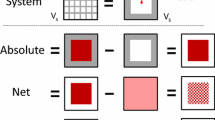Abstract
Specific volume quantities of macromolecules are of importance in connection with a variety of physico-chemical and biochemical techniques, such as analytical ultracentrifugation and small-angle scattering, e.g., for the determination of molecular weights in two- and multicomponent solutions. Specific volumes may be obtained from density experiments, calculations, or reliable approximations. Experimental values for the partial specific volume (¯v) of native conjugated proteins in aqueous solution vary in a wide range (0.59-1.05 cm3/g), while the values for nonconjugated proteins cluster around 0.735 cm3/g, as follows from a thorough investigation of the relevant literature. Volumes of conjugated proteins are substantially influenced by the nature and content of the nonprotein moiety. Typical glyco-, nucleo-, and metalloproteins show ¯v- values lower than those found for nonconjugated proteins, while lipoproteins exhibit high values. The ¯v-values of conjugated proteins in dilute salt or buffer solution (≤0.2 M) may be assumed to be composed additively from compositional increments. Based on the composition and assumed average values for the partial specific volumes of the main constituents of conjugated proteins (¯v a =0.54, 0.61, 0.735, and 1.02 cm3/g for the nucleic acid, carbohydrate, protein, and lipid moieties, respectively), reliable calculations can be performed if some precautions are taken into account. In this context the theoretical background will be discussed, especially with respect to ultracentrifugal experiments in multicomponent solutions.
Similar content being viewed by others
References
Casassa EF, Eisenberg H (1964) Adv Prot Chem 19:287–395
Eisenberg H (1974) In: Ts'o POP (ed) Basic Principles in Nucleic Acid Chemistry, Vol II. Academic Press, New York London, pp 171–264
Eisenberg H (1976) Biological Macromolecules and Polyelectrolytes in Solution. Clarendon Press, Oxford
Eisenberg H (1981) Q Rev Biophys 14:141–172
Kupke DW (1973) In: Leach SJ (ed) Physical Principles and Techniques of Protein Chemistry, Part C. Academic Press, New York London, pp 1–75
Lee JC, Gekko K, Timasheff SN (1979) Methods Enzymol 61:26–49
Durchschlag H (1986) In: Hinz H-J(ed) Thermodynamic Data for Biochemistry and Biotechnology. Springer Verlag, Berlin Heidelberg New York Tokyo, pp 45–128
Durchschlag H (1989) Life Sci Adv Ser D, in press
Chervenka CH (1973) A Manual of Methods for the Analytical Ultracentrifuge. Spinco Division of Beckman Instruments, Palo Alto
Van Holde KE (1975) In: Neurath H, Hill RC (eds) The Proteins, Vol 1, 3rd ed. Academic Press, New York San Francisco London, pp 225–291
Pundak S, Eisenberg H (1981) Eur J Biochem 118:463–470
Durchschlag H, Jaenicke R (1983) Int J Biol Macromol 5:143–148
Kratky O, Leopold H, Stabinger H (1973) Methods Enzymol 27:98–110
Durchschlag H, Jaenicke R (1982) Biochem Biophys Res Commun 108:1074–1079
Durchschlag H (1985) In: Gangli P, Varga L (eds) Collected Abstracts, 12th Hungarian Diffraction Conference, Roland Eötvös Physical Society, Sopron, pp 106–107
Durchschlag H (1985) In: Laggner P, Müller K (eds) Abstracts, EMBO Practical Course on Differential Scanning Calorimetry and Scanning Densitometry of Biological Systems. Institut für Röntgenfeinstrukturforschung, Graz, pp D1–7
Traube J (1899) Samml Chem Vortr 4:255–332
Cohn EJ, Edsall JT (1943) In: Cohn EJ, Edsall JT (eds) Proteins, Amino Acids and Peptides as Ions and Dipolar Ions. Reinhold, New York, pp 370–381; Reprint (1965) by Hafner, New York
Zamyatnin AA (1972) Progr Biophys Mol Biol 24:107–123
Perkins SJ, Miller A, Hardingham TE, Muir H (1981) J Mol Biol 150:69–95
Perkins SJ (1986) Eur J Biochem 157:169–180
Author information
Authors and Affiliations
Additional information
Dedicated to Professor Dr. Josef Schurz on the occasion of his 65th birthday.
Rights and permissions
About this article
Cite this article
Durchschlag, H. Determination of the partial specific volume of conjugated proteins. Colloid & Polymer Sci 267, 1139–1150 (1989). https://doi.org/10.1007/BF01496937
Received:
Accepted:
Issue Date:
DOI: https://doi.org/10.1007/BF01496937




